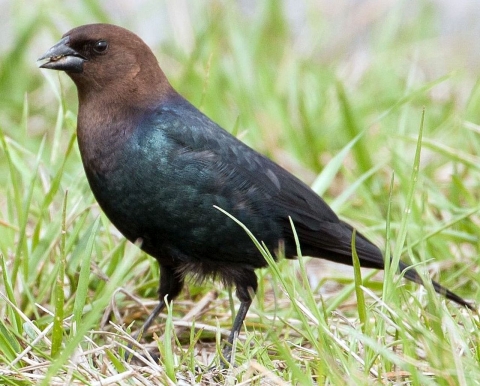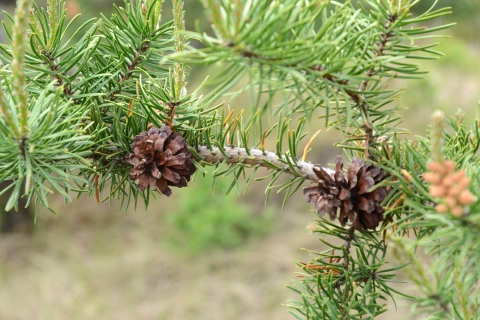What We Do
The National Wildlife Refuge System is a series of lands and waters owned and managed by the U.S. Fish and Wildlife Service. Wildlife management areas are part of the refuge system and wildlife conservation is at our core. It drives everything we do from the purpose an area is established, to the recreational activities offered there, to the resource management tools we use. Selecting the right tools helps us ensure the survival of local plants and animals and helps fulfill the purpose of the area.
Management activities:
- Planning
- Nuisance Species Management
- Surveys and Censuses
- Studies and Investigations
- Forest Management
Management and Conservation
Refuges use a wide range of land management tools based on the best science available. Some refuges use prescribed fires to mimic natural fires that would have cleared old vegetation from the land helping native plants regenerate and local wildlife to thrive. Other refuges contain wilderness areas where land is largely managed passively. The management tools used are aimed at ensuring a balanced conservation approach where both wildlife and people will benefit. At this field station our conservation toolbox includes:
Planning
In 2019, as the Kirtland’s warbler was being delisted or removed from the Federal Endangered Species List and the U.S. Fish and Wildlife Service put the post-delisting monitoring plan for the Kirtland’s warbler into action. This plan outlines the steps necessary to verify that a species delisted due to recovery remains secure from risk of extinction after the protections of the Endangered Species Act no longer apply.
Nuisance Species Management
Brown-headed cowbirds are native to North America and are brood parasites, meaning they lay their eggs in other birds’ nests. It isn’t their fault. They evolved this ability which allowed them to follow the herds of North American bison as they moved across the prairies. They fed on the insects the bison stirred up. If they had been tied to a nest it would have made following the heard impossible, so this trait allowed them to remain on the go.
Since the 1800s brown-headed cowbirds have been able to expand their territory. They prefer grasslands and open habitats. People have replaced the bison. We plow up lands for agriculture and lawns, fragmenting forests to build roads and build our homes. This activity has benefitted brown-headed cowbirds and allowed them to move into new areas, expanding their population. If brown-headed cowbird populations become too high in an area it can begin to affect other bird populations. It takes a while for evolution to catch up. Some bird species are catching on and will throw the imposter eggs out of the nest. Others still need to figure this trick out.
More than 140 species of birds have been known to host cowbirds including red-winged blackbirds, song sparrows and various species of warblers including Kirtland’s warblers. The young cowbirds are usually larger than the host bird’s young and tend to beg more, getting more food and generally out compete the smaller birds.
Because of this, brown-headed cowbird populations need to be monitored in the Kirtland’s warbler nesting territory. If the cowbird population becomes too high, steps will need to be taken to reduce the number. This is accomplished through a trapping program.
Surveys and Censuses
Every other year a census or selective survey for singing male Kirtland’s warblers will be conducted. This will help ensure that the population of birds is stable or increasing. If the number of warblers begins to decrease the cause of the decrease will need to be identified and addressed. The goal is to keep the warbler from needing to be placed back on the Endangered Species List.
Studies and Investigations
Kirtland’s warblers nest in Michigan, Wisconsin and Ontario, Canada, but they winter in the Bahamas. There is a need to track and study the birds through their entire life cycle to ensure their continued success. If issues related to their population’s stability are identified it is better to address them before they need to be placed back on the Endangered Species List.
Forest Management
Kirtland’s warblers are sensitive birds which require young jack pine forests between four and 25 years old and that are at least 80 acres in size. Historically, wildfires used to burn through the jack pine barrens that the warblers call home. This would regenerate young jack pine stands. As more and more people moved into these areas and built their homes, wildfires were suppressed for human safety and property security. This had unintended consequences. The jack pine forests were unable to burn and regenerate causing loss of habitat for the Kirtland’s warbler and other species that depend on this cycle of wildfire.
To help the Kirtland’s warbler and other species that depend on this cycle wildlife managers are experimenting with alternative methods that mimic wildfire. Mainly large-scale timber harvesting by cutting older jack pine forests and replanting jack pines in their place. This needs to be done in a way which keeps a portion of the forests in the 4-25 year age range.
Law Enforcement
Kirtland’s Warbler Wildlife Management Area is managed by the Seney National Wildlife Refuge. If you witness or suspect a wildlife or area violation:
Law enforcement issues should be referred the U.S. Fish and Wildlife Service tips line at 1-844-FWS-TIPS (397-8477).
Laws and Regulations
Kirtland’s Warbler Wildlife Management Area welcomes visitors. We want you to enjoy your visit while keeping the area in pristine condition for you, future guests and the wildlife and plants that call the area home. During your visit we ask you to follow these regulations which help us ensure our mission.


